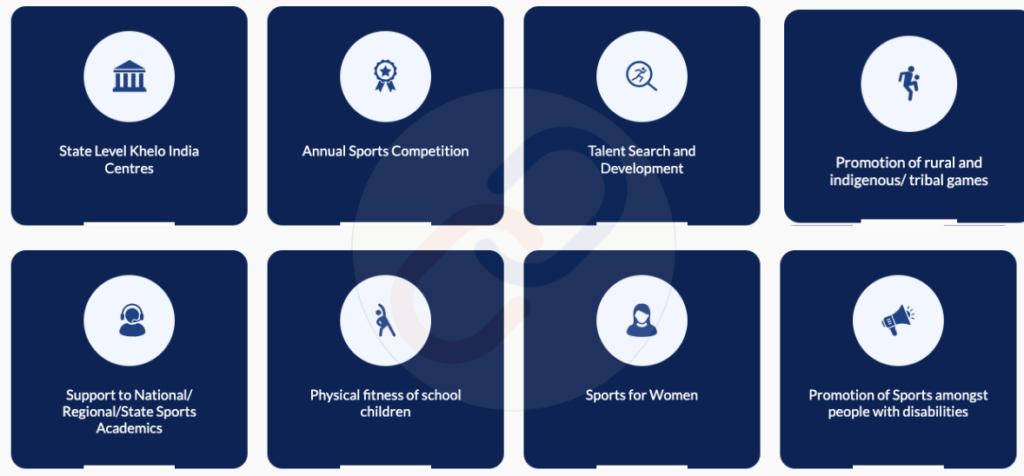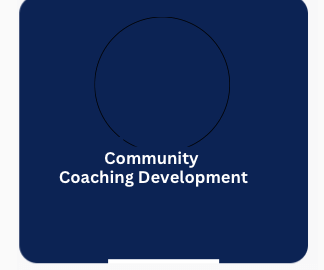Sports Authority of India and Rajasthan State Sports Council Sports Policies of India and Rajasthan State play a pivotal role in shaping the athletic and physical education landscape of the country and the state. In the broader subject of Sports and Yoga, these policies provide structure, support, and opportunities for athletes, coaches, and fitness enthusiasts. By aligning national goals with regional needs, both the Sports Authority of India and the Rajasthan State Sports Council work collaboratively to promote grassroots development, enhance infrastructure, and encourage participation in diverse sports and yoga activities across all age groups.
Previous Years Questions
| Year | Question | Marks |
| 2021 | Name any 4 sports academies governed by Rajasthan State Sports Council. | 2M |
| 2018 | Write a short note on P.S.P.B. Table Tennis Academy. | 5M |
| 2018 | Explain the hierarchy of the members of “Rajasthan State Sports Council”. | 2M |
Sports Authority of India

- The Sports Authority of India (SAI) was established in 1984.
- It was created to continue the legacy of the IXth Asian Games held in New Delhi in 1982.
- SAI operates under the Department of Sports, Govt. of India.
- SAI was registered as a Society under the Societies Act, 1860.
- SAI plays a significant role in developing sports in India.
- It provides training to elite athletes.
- SAI also operates various schemes for:
- Identifying young talent.
- Developing young athletes.
- These schemes are implemented through regional and training centres across India.
- SAI offers academic programs in physical education and sports.
- It is responsible for maintaining and utilizing several major stadia in Delhi.
- Regional Offices of SAI are located at Bengaluru , Kolkata , Gandhinagar , Kandivali (Mumbai) , Bhopal , Sonipat , Lucknow , Chandigarh , Guwahati and Imphal.
- Governing Body of SAI includes :
- Members including Chairman – 36
- Tenure – 3 years
AIMS AND OBJECTIVES
- Talent Scouting at micro level & Nurturing talent towards excellence
- Training & International Exposure
- Support Training with Scientific & Sports Equipment and scientific personnel
- Monitor and enhance Performance with a scientific evaluation system
- Training and preparation of National teams
- Sports Infrastructure Development & Maintenance
- Maintenance and up gradation of 4 stadia complexes and a shooting range in Delhi
- To produce coaches and physical educationists of high caliber in different disciplines of sports to broad base sports
- To implement various schemes of the MYAS e.g. Khelo India , Assistance to NSF, TOPS, FIT India
- These stadia were constructed or renovated for the IX Asian Games in 1982:
- Jawaharlal Nehru Sports Stadium
- Indira Gandhi Sports Complex
- Major Dhyan Chand National Stadium
- Dr. Syama Prasad Mookherjee Swimming Pool Complex
- Dr. Karni Singh Shooting Ranges.
APPROACH & STRATEGY
The development of sports and promotion of excellence, including international performance, is complex and multi-dimensional.
Strategies include:
- International collaboration for sports development and excellence.
- Creating a structured system for talent identification in Olympic and indigenous sports.
- Focusing on regions with potential for excellence in specific sports.
- Establishing infrastructure and a framework for training across different age and skill levels.
- Involving SAI, State Governments, and National Sports Federations (NSFs) in training programs.
- Encouraging corporate involvement in developing academies and Centres of Excellence.
- Improving coaching development and supervision.
- Strengthening scientific and technical support for athletes.
- Ensuring the availability of quality sports goods and promoting the indigenous sports goods industry.
National Centres of Excellence
- Sports Authority of India (SAI) has established National Centres of Excellence (NCOEs) to train athletes for Olympics and international events.
- NCOEs provide:
- Specialized training with state-of-the-art infrastructure.
- Sports science support and individualized diets from trained nutritionists.
- Supervision by top coaches, qualified staff, and High Performance Directors.
- NCOEs function as regular coaching camps for India’s best talent.
- They offer a talent pool for National Team selection, with alternative options for second and third choices.
- NCOEs accommodate athletes from elite to developmental levels.
6 Pillars

- Athlete
- Coach
- Sports Science Support
- High Quality Field of Play
- World Class Infrastructure
- Diet as per requirement
National Centres of Excellence (NCOEs) focus on 23 priority disciplines where Indian athletes show strong performance and medal potential in international events.
| Archery | Handball | Kayaking & Canoeing | Swimming |
| Athletics | Judo | Powerlifting | Taekwondo |
| Boxing | Kabaddi | Rowing | Table Tennis |
| Cycling | Kho-Kho | Shooting | Volleyball |
| Fencing | Gymnastics | Football | Wrestling |
| Hockey | Wushu | Weightlifting |
Sports Promotion Schemes
- National Centres of Excellence (NCOE)
- SAI Training Centre(s) (STCs)
- Extension Centre of STC/SAGs
- NSTC
- Regular Schools
- Indigenous Games & Martial Arts(IGMAs)
- Akharas
- The Operation Division of SAI oversees the implementation of sports promotional schemes aimed at scouting and nurturing talented athletes in various age groups to achieve national and international excellence.
- These schemes are implemented through SAI’s Regional Centres located at:
| Bengaluru | Sonepat | Guwahati |
| Kolkata | Lucknow | Imphal |
| Gandhinagar | Chandigarh | Bhopal |
| Kandiveli (Mumbai) | ||
Academic Wings are located at:
- Netaji Subhas National Institute of Sports, Patiala
- The Lakshmibai National College of Physical Education (LNCPE)Thiruvananthapuram
Sports Science facilities are well developed at Patiala, Bengaluru, and Kolkata, with upgrades planned at other Centres.
Target Olympic Podium Scheme (TOPS)

- The Ministry of Youth Affairs and Sports (MYAS) started the Target Olympic Podium Scheme (TOPS) in September 2014.
- The scheme was revamped in April 2018 to create a technical support team for managing TOPS athletes.
- TOPS provides holistic support to athletes identified for Olympic and Paralympic Games.
- Identification elite athletes who can achieve the Olympic podium is done by a committee – TOPS Elite Athletes Identification Committee
- Support includes:
- Foreign training
- International competition participation
- Equipment provision
- Coaching camps
- Monthly stipend of ₹50,000 for each athlete
- TOPS is a flagship program aimed at assisting India’s top athletes to enhance their preparations for winning Olympic medals.
Mission Olympic Cell (MOC)
- The Mission Olympic Cell (MOC) is a dedicated body to assist athletes selected under the TOP Scheme.
- The MOC is chaired by the Director General of the Sports Authority of India (DG, SAI).
- Committee meetings include:
- Representatives from respective National Sports Federations (NSFs)
- Project Officers of SAI
- Other members
- The purpose of the MOC is to:
- Debate, Discuss, and Decide on processes and methods to provide the best assistance to athletes.
- Focus areas of the MOC include:
- Selection, exclusion, and retention of athletes.
- Selection of coaches and training institutes that can receive TOPS assistance.
Functions :
- Approve customized programs for TOP Scheme athletes.
- Recommend funding for these programs.
- Monitor and review athlete progress in training.
- Address sudden needs of athletes.
- Communicate regularly with athletes about their progress.
- Work with partner agencies to implement functions.
- Ensure documentation and contracts for beneficiaries.
- Fulfill commitments to sponsors and partners under the NSDF TOP Scheme.
Khelo India
Khelo India National Programme for Development of Sports was introduced by the Ministry of Sports and Youth affairs to revive sports culture in India at grass-root level and establish India as a great sporting nation.
- The programme strives to promote “Sports for Excellence” as well as “Sports for All”.
Khelo India is a merger of the following schemes:
- Rajiv Gandhi Khel Abhiyan (RGKA)
- Urban Sports Infrastructure Scheme (USIS)
- National Sports Talent Search Scheme (NSTSS)
It includes 16 disciplines:
Archery, Athletics, Badminton, Basketball, Boxing, Football, Gymnastics, Hockey, Judo, Kabaddi, Kho-Kho, Shooting, Swimming, Volleyball, Weightlifting, and Wrestling.
Objective:
- Mainstreaming sport as tool for individual development, community development, economic development and national development.
- Khelo India programme has been divided into 12 verticals: 8 implemented by SAI, 3 by Ministry of Youth Affairs & Sports, 1 by Lakshmi Bai National Institute of Physical Education
Implemented by the Sports Authority of India:

- State Level Khelo India Centres
- Annual Sports Competitions
- Talent Search and Development
- Sports for Women
- Support to National/Regional/State Sports Academies
- Promotion of Sports for Persons with Disabilities
- Promotion of Rural and Indigenous/Tribal Games
- Physical Fitness for School-going Children
Implemented by the Ministry of Youth Affairs & Sports:

- Play Field Development
- Creation/Upgradation of Sports Infrastructure
- Sports for Peace and Development
Implemented by Lakshmi Bai National Institute of Physical Education (LNIPE).

- Community Coaching Development
Khelo India centres
- At present the total number of Khelo India centres across India is 960 Of which 715 are operational .
- In Rajasthan earlier number of Khelo India centers was 33 currently there are a total of 51 Khelo India centers
Fit India Movement

- Launch Date: 29th August 2019 by the Honourable Prime Minister.
- Objective: To make fitness an integral part of daily life.
- Mission: To bring about behavioral changes towards a more physically active lifestyle
Key Objectives:
- Promote fitness as easy, fun, and free.
- Spread awareness about fitness and physical activities through focused campaigns.
- Encourage indigenous sports.
- Ensure fitness reaches every school, college/university, panchayat/village, etc.
- Create a platform for citizens to share information, drive awareness, and share personal fitness stories.
Significance of Fit India Movement:
- Awareness and Behavior Change, transformation in the public mindset towards fitness, reduce the prevalence of lifestyle diseases.
- wide-ranging support from the government, educational institutions, sports organizations, and health bodies.
- development of fitness infrastructure in both urban and rural areas. This includes the establishment of fitness centers, parks, walking tracks, and sports facilities.
- engaged communities in fitness activities,via events, fitness challenges, and campaigns.
Khelo India Youth Games
- Launched by: Prime Minister Narendra Modi in 2018
- Initially known as: Khelo India School Games.
- Name changed to: Khelo India Youth Games in 2019.
- Held annually: Every year in January or February.
- Objective: To promote sports culture and identify sports talent at the grassroots level as part of the Khelo India initiative.
- 2023 Event: Khelo India Youth Games 2023 was held in Tamil Nadu in January 2024.
- Upcoming Event: The Khelo India Youth Games (KIYG) and Para Games will be organized in Bihar in April 2025.
National Youth Policy of India
- First introduced in 2003
- Revised in 2014
- It provides a framework for the development and empowerment of youth and outlines the government’s role in guiding and promoting the welfare of youth in the country.
- The policy focuses on creating an environment where young people can be active contributors to the nation’s growth while ensuring their holistic development.
Objectives:
- Empowerment of Youth: by providing opportunities for participation in governance, education, and community development, thereby strengthening their role in society.
- Health and Well-being: Ensuring the physical, mental, and emotional well-being of youth. Ensuring access to health services, mental health support, and recreational activities.
- Education and Skills Development: encouragement to education and skills development to improve employability. Technical skills, entrepreneurship training, and vocational education to be focused.
- Social Inclusion: Promoting social inclusion by addressing the challenges faced by marginalized youth, girls, and minority communities.
- Youth Participation in Nation Building: The policy emphasizes the importance of active participation of youth in political, social, and cultural processes, contributing to the democratic fabric of India.
- Environmental Sustainability: The policy promotes environmental education and sustainable development by making youth aware of their environmental responsibilities and engaging them in environmental conservation.
- It emphasizes decentralized approach and collaboration between various stakeholders such as- Government Ministries and Departments, Non-Governmental Organizations (NGOs), Private Sector, Educational Institutions, Youth Organizations.
Rajasthan State Sports Council
Rajasthan State Sports Council is the apex body in Rajasthan at the State level to look after the development of sports activities and providing coaching to the players of the state.
- It was set up in 1957 by the Government of Rajasthan.
- under the control of Youth Affairs and Sports Department.
- it is registered as a society under Rajasthan state society act, 1958.
Rajasthan State Sports Council Structure:
- Patron: Governor of Rajasthan.
- Deputy Patron: Chief Minister of Rajasthan.
- Chairman: Chief Executive of the Council.
- Other Key Members:
- Vice President.
- Treasurer.
- Over 12 members nominated by the State Government.
- 6 ex-officio members.
Historical Leadership:
- Mr. V.G. Kanetkar was the first president of the council.
- Current President (09 September, 2024): Dr. Neeraj Kumar Pawan, Secretary to Government, Youth Affairs and Sports Department Rajasthan.
- Released Draft Sports Policy: Rajasthan state Sports Policy – 2013
Administrative System:
Posts for Sports Activities and Administration:
- 483 posts created for sports activities and administrative work.
- 235 officer cadre posts, including:
- Secretary of the council, subordinate cadre, ministerial cadre, and assistant cadre.
- 103 officer posts filled, 132 posts vacant.
- 248 sports instructor posts sanctioned for free sports training.
District Sports Training Centres:
- Functioning in all 33 districts to promote sports and provide regular training.
- Staff includes a sports officer/in-charge, junior clerk, and trainers based on district-specific popular sports.
- Watchmen and game boys employed for office and ground maintenance.
Role of District Sports Officer:
- Organises competitions of various games.
- Provides intensive training to promising players with the help of subordinate staff and trainers.
Initiatives to Encourage Sports
Rajasthan has implemented several initiatives to encourage sports and support athletes:
- Rajasthan State Sport Policy 2013: with the aim of Developing facilities and opportunities to become a national leader and gain international recognition.
- Rural Olympics: The first-ever Rural Olympics involved 25 to 40 lakh players to promote sports at the village level.
- Honoring Achievements: Awards like the Maharana Pratap Award and the Guru Vashishtha Award recognize outstanding athletes and coaches.
- Enhanced Prize Money: Significantly increased cash prizes for Olympic and other international medalists, with up to Rs 3 crore for an Olympic gold medal.
- Employment Opportunities: Job appointments in government services for medal winners on an out-of-turn basis.
- Sports Infrastructure: Development of sports facilities and support for private entities to build infrastructure, including the establishment of Rajasthan Sports University.
- Training Camps: Annual residential training camps, including specialized camps for tribal areas.
- Sports Academies and Hostels: Various academies and hostels provide training and support to young athletes.
- Reservation and Benefits: 2% reservation in government jobs for outstanding sportspersons, along with other benefits like concessional land, free travel, and daily allowances.
- Institutional Support: The Rajasthan State Sports Council approves policies and important schemes for the promotion of sports in the state, with other functions as outlined below.
- Sports Associations to Promote Sports: Governed by The Rajasthan Sports (Registration, Recognition, and Regulation of Associations) Act, 2005.
FAQ (Previous year questions)
Courses: M.Sc. Sports Physiology
M.Sc. Sports Biochemistry
M.Sc. Sports Nutrition
M.Sc. in Sports Biomechanics
M.A. In Sports Psychology
University: Central University of Rajasthan (CURAJ)
Sports academies governed by Rajasthan State Sports Council.
Girls Basketball Academy, Jaipur
Girls Hockey Academy, Ajmer
Boys Football Academy, Jodhpur
Boys Kabaddi Academy, Karauli
Boys Basketball Academy, Jaisalmer
P.S.P.B. Table Tennis Academy
The PSPB (Petroleum Sports Promotion Board) Table Tennis Academy was established in 1994 in collaboration with SAI and TTFI at Ajmer, Rajasthan to develop players who are capable of successfully performing at junior and subsequently at the senior international stage.
PSPB aims at becoming a High Performance Center in the world.
Provide high quality coaching to players from a young age (8 year onwards)
Bring about real and sustained increases in the quality and quantity of Indian skilled table tennis players (currently 15 players) with an objective to help India achieve an Olympic Medal.
Develop a network of young player feeder programmes (cadet age group) that provide an appropriate supply of players into the National team at different age groups.
Currently the Academy is located in DPS, Sonepat.
Rajasthan State Sports Council is the apex body in Rajasthan at the State level, set up in 1957 under the control of Youth Affairs and Sports Department to look after the development of sports activities and providing coaching to the players of the state.
Rajasthan State Sports Council Structure:
Patron: Governor of Rajasthan.
Deputy Patron: Chief Minister of Rajasthan.
Chairman: Chief Executive of the Council.
Other Key Members: Vice President.
Treasurer.
Over 12 members nominated by the State Government.
6 ex-officio members.
